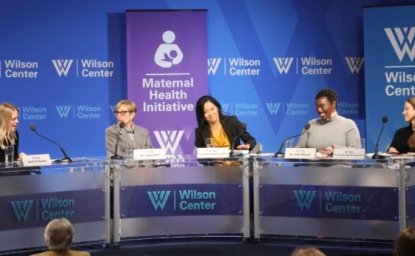In developing countries, a staggering number of mothers die annually as a result of childbirth. While most countries have made progress in maternal health, more than 500,000 women die of pregnancy-related complications each year, nearly 90 percent of them in sub-Saharan Africa and South Asia alone. Yet most of these deaths can be prevented with skilled care at birth and increased access to quality medical facilities.
The need is great for investment in maternal health, from family planning and prenatal care to access to skilled birth attendants and emergency obstetric care. In the developing world, financial barriers and cultural attitudes are just a couple of the many challenges associated with maternal health.
There is also a great need to treat and prevent disabling conditions such as eclampsia and fistula. For every one mother who dies from obstetric care, 30 more suffer from infection, complications, and other conditions that jeopardize their health.
The Wilson Center's Global Health Initiative's (GHI) Advancing Policy Dialogue on Maternal Health Series aims to raise awareness and improve communication among stakeholders to help facilitate better policies and programs worldwide. GHI is co-convening this series with the Maternal Health Task Force and the United Nations Population Fund (UNFPA), and is grateful to USAID's Bureau for Global Health for further technical assistance.
Human Resources for Maternal Health
At a January 6 meeting, the second in the Advancing Policy Dialogue series, panelists concurred that increased access to skilled health workers during pregnancy and delivery, including midwives and other practitioners, can significantly reduce maternal mortality in developing countries. One solution to the current human resource crisis is to acknowledge and expand the skills and responsibilities of non-physician health workers.
"Pregnancy is not a disease, a woman should not die of pregnancy…it doesn't need a new drug…it doesn't need research—we just need a skilled workforce at different levels," said Seble Frehywot, assistant research professor of health policy and global health at the George Washington University.
Countries with the highest maternal mortality rates also have the greatest worker shortage, said Frehywot. In Africa, for every 10,000 births, only 2 physicians and 11 nurses or midwives are present at delivery. According to the World Health Organization, at least 53 skilled health care workers (nurses, doctors, midwives) are needed per 10,000 births to meet Millennium Goal 5, which seeks to reduce maternal deaths by 75 percent by 2015.
Scaling-up human resources requires task-shifting, such as doctors to non-physician health clinicians and nurses or midwives to community health care workers. Frehywot emphasized the need for a sound regulatory framework that addresses standard of care, training, certification, and supervision. To ensure long-term success, she also underscored the need for political buy-in and commitment from the Ministry of Health, medical universities, and professional associations.
"Maternal mortality ratios in Afghanistan are the second highest in the world," said Jeffrey Smith, regional technical director for Asia at Jhpiego, an international health organization. In 2002, when Smith arrived in Afghanistan, there was a shortage of skilled health workers and no functional schools for training. "The most important decision made early in the reconstruction [of] Afghanistan was that midwives would be the backbone of the reproductive health workforce and they would be empowered with the skills to perform the tasks necessary for provision of basic emergency obstetric care," said Smith.
"Task shifting should not be a temporary fix until we have more doctors," argued Smith. In this post-conflict setting, he said task-shifting has evolved from an emergency approach to a development strategy for professionalizing the workforce and rebuilding the health system. Afghanistan's Ministry of Public Health was imperative to the success of scaling up midwives, taking steps to ensure the midwifery schools maintained legitimacy and received formal accreditation.
Smith also discussed the importance of empowering health workers on the front line so that they may provide services in the most peripheral areas.
Improving donor coordination is essential to improving the maternal health system, said Pape Gaye, president and CEO of IntraHealth. Gaye discussed the implications for training generation "Y," emphasizing the importance of including new technologies available for training, including PDAs and e-learning courses.
Performance outcomes and training are the two key pillars of effective scale-up, said Gaye. "This is not simple work; you really need to have a systems approach," said Gaye. "What we seek in the end is good integration—across systems, across roles, courses, learning processes, and training, for maximum adaptability."
HIV/AIDS and Maternal Health Services
Integrating HIV/AIDS and maternal health services not only improves health outcomes, but also increases program efficiency, strengthens health systems, and saves money. At this first event of the Advancing Policy Dialogue series on December 3, Dr. Claudes Kamenga, senior director of technical support and research utilization at Family Health International, said, "We need to integrate [services] because clients seeking HIV services and those seeking reproductive health services share common needs," especially those women who have HIV/AIDS and become pregnant.
"Contraception is a cost-effective intervention…and the best kept secret in HIV prevention," Kamenga said. Demographic health surveys demonstrate that HIV-positive women want immediate access to family planning services to prevent unintended pregnancies, which also decreases transmission and the risk of maternal mortality.
The international donor community, including the Global Fund and President's Emergency Plan for AIDS Relief (PEPFAR), is increasingly recognizing the need to integrate maternal health and HIV services. However, additional research and evidence is needed to further support integration. At the service delivery level, Kamenga said, "human resource capacity, supervision, reporting, referral systems, and community involvement" must be integrated in an unbiased manner.
"Women who are HIV-infected have maternal mortality rates that are five times higher than non-infected women…we have to come together around a cohesive approach," said Michele Moloney-Kitts, assistant coordinator at the Office of the U.S. Global AIDS Coordinator. Moloney-Kitts discussed the need to integrate co-existing services and funding streams and to tailor donor and policy responses to the changing needs of the HIV epidemic, such as the unmet need for contraception and family planning.
Moloney-Kitts also discussed PEPFAR's commitment to integrate HIV/AIDS with other female-specific global health issues–such as cervical cancer–that will maximize impact on health systems and increase overall data availability. Such data can then be used to improve service delivery and future policy decisions.
For young people born with HIV/AIDS, the available maternal and HIV health services are not adequate, said Harriet Birungi, program associate with the Population Council in Kenya. Current policies and programs fail to include HIV-positive adolescents because of the stigma associated with the disease and the failure to acknowledge the rights of intimacy among this cohort. However, leaving this group out of reproductive health programs has serious consequences, including high unintended pregnancy and maternal mortality rates, and increased rates of infants born with HIV.
Birungi's research with HIV-positive adolescents in Kenya and Uganda found that only 41 percent of sexually active adolescent girls in Uganda, and 48 percent in Kenya, utilize contraception due to issues of self-esteem and a lack of sexual and reproductive health information. She argued that counselors must appropriately respond to this need.
"We cannot talk about integration if service providers are not respecting the rights of young people," Birungi said. Screening HIV-positive adolescents for their reproductive health needs has significant potential to identify those who are pregnant and require additional maternal and other health services such as malaria prevention and postpartum family planning, she said. "Many of the HIV-positive adolescents are already receiving anti-retroviral therapy [ART] and visit [HIV] clinics regularly," which provides a unique opportunity to strengthen these linkages and integrate services.
Additional meetings in this maternal health series will take place throughout the year. These meetings will include such topics as maternal and newborn health; the impact of maternal mortality on economic development; community-based and faith-based approaches to maternal health; nutrition, and workplace policies and programs for mothers.





